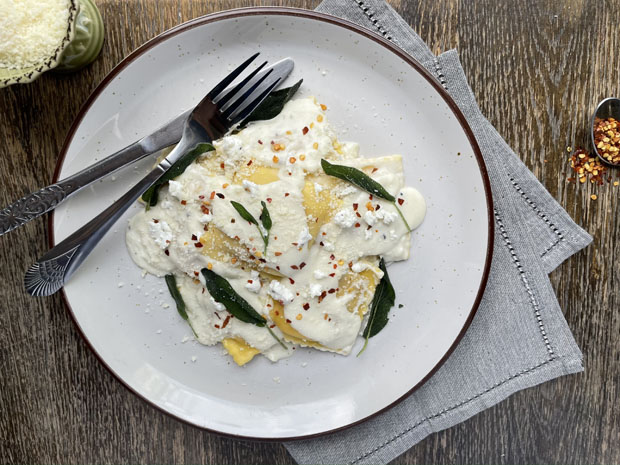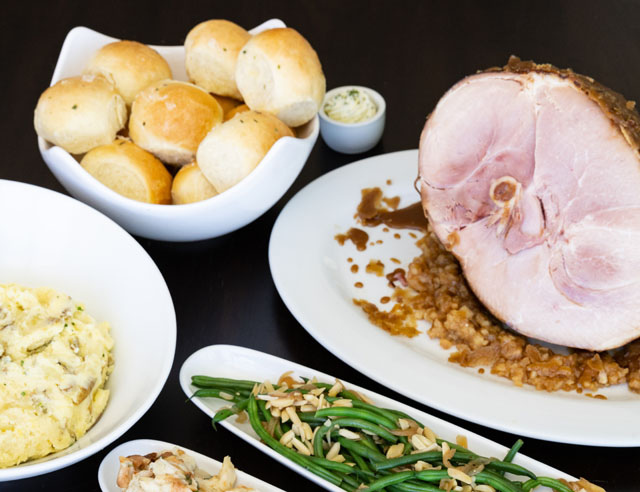Seasonal Stunners with a Secret
03 Sep 2022
Six impressively simple dishes you’ll fall for this year
Recipes and photos by Fanny Slater

We get it. The instant the inkling of pumpkin spice anything creeps around the corner, we mentally prepare by pulling out our comfiest cardigans and corralling the crock pot off the shelf, too. You’re not alone. After a scorching summer where crushed ice was the only appealing appetizer, nothing sounds better than sweater weather with a side of comfort food. In this recipe roundup, we’re celebrating the arrival of autumn by merging two themes:
Big, bourgie-sounding flavors that secretly get by with a little help from their store-bought friends.
Ravioli with Goat Cheese Cream Sauce & Fried Sage
Yield: 4 to 6 servings
Small bunch fresh sage leaves
Canola oil for frying (or another neutral oil with a high smoke point)
1 teaspoon plus a pinch coarse salt, plus more to taste
18-ounce package store-bought ravioli
1 tablespoon olive oil
4 tablespoons unsalted butter
3 large cloves garlic, minced
4 tablespoons all-purpose flour
2 cups half-and-half
4 ounces goat cheese, crumbled
1/4 cup freshly grated Parmesan cheese, plus more for serving
1/2 teaspoon ground black pepper
1/8 teaspoon freshly ground nutmeg
Crushed red pepper flakes (optional)
Place a heavy-bottomed skillet over medium-high heat and line a plate with paper towels.
Add enough canola oil to coat the bottom and come up about 1 inch. Heat the oil until it reaches 375°F on a deep-fry or candy thermometer. If you don’t have a thermometer, just look for the oil to be lightly shimmering. You can also drop in one leaf to test the heat. It should sizzle and float.
When the oil is ready, add the sage leaves in a single layer, working in batches if necessary.
Larger leaves will take 30 seconds or less and smaller ones will take under 10 seconds to fry. Using a slotted spoon, transfer the fried herbs to the paper towel-lined plate and immediately sprinkle with a pinch of salt. Repeat in batches until all the sage leaves are fried.
Bring a large pot of salted water to a boil and cook the ravioli according to package instructions. Before draining, reserve 1 cup of the starchy cooking water and set it aside. Drain the pasta and toss it with the olive oil to prevent sticking.
Return the pasta pot to the stove over medium-low heat and add the butter. Once it begins to lightly foam and sizzle, add the garlic and cook for 1 minute, stirring constantly.
Whisk the flour into the butter and cook, whisking often, for about 3 to 5 minutes to cook out the raw flavor of the flour. The roux should be lightly golden. While continuing to whisk, gradually pour in the half-and-half a few tablespoons at a time, making sure no clumps form.
Increase the heat to medium-high and bring the sauce to a boil. Cook for 1 minute, stirring constantly until thickened. Stir in the goat cheese, Parmesan, 1 teaspoon salt, black pepper, and nutmeg. Cook for 1 more minute.
Fold ravioli into the sauce, splashing in a few tablespoons of reserved cooking water at a time so the sauce clings to the pasta and is thinned to the desired texture. Continue tossing in the warm sauce over low heat until fully heated through.
Season the sauce to taste with additional salt if necessary.
Divide the ravioli among plates and garnish with additional grated parmesan, crushed red pepper flakes, and the fried sage leaves.
Brown Butter Pumpkin Spice Granola
Yield: Approximately 5 cups
6 tablespoons unsalted butter
1/4 cup dark brown sugar
1/4 cup pure maple syrup
1/3 cup canned pumpkin
1 teaspoon pure vanilla extract
3 cups old-fashioned oats
1 cup roughly chopped raw walnuts (or mixture of walnuts and pecans)
1/2 cup raw unsalted pumpkin seeds
1 tablespoons sesame seeds
3 1/2 teaspoons pumpkin pie spice
1/4 cup dried unsweetened cranberries or cherries
Preheat the oven to 275°F and line a rimmed baking sheet with parchment paper.
In a medium saucepot over medium-low heat, melt the butter. Whisk until foamy and then continue stirring occasionally until the butter turns a deep golden color, develops dark flecks, and releases a nutty aroma, about 5 minutes.
Immediately remove the pot from the heat and pour the butter through a fine mesh strainer into a medium-size bowl.
While the brown butter is still warm, whisk in the brown sugar, maple syrup, canned pumpkin, and vanilla.
In a separate large mixing bowl, combine the oats, walnuts, pumpkin seeds, sesame seeds, and pumpkin pie spice.
Gently fold the brown butter-pumpkin mixture into the oat mixture until everything is thoroughly coated. Spread the granola onto the baking sheet, evenly flattening with the back of a spatula.
Bake for 40 to 50 minutes, pushing the granola around every 15 minutes, until the granola is golden brown and very fragrant.
Allow the granola to cool completely in the pan, and then break it up with your fingers, leaving some bigger clusters for more texture. Fold in the cranberries, then store in an airtight container at room temperature on the counter for up to 2 weeks.
Skillet Chicken Thighs with Caramelized Shallots & Winter Squash
Yield: 4 servings
2 tablespoons olive oil
1 tablespoon unsalted butter
8 bone-in, skin-on chicken thighs (about 3 pounds)
2 teaspoons plus a pinch coarse salt, plus more to taste
2 teaspoons plus a pinch freshly ground black pepper
1/2 teaspoon ground paprika
2 large shallots, quartered
1 small acorn squash, halved, seeded and sliced into 1 1/2-inch-thick half-moons
1/4 cup dry white wine
1/2 cup low-sodium chicken stock
2 tablespoons chopped fresh thyme, divided
Store-bought roasted potatoes
Preheat the oven to 425°F.
Season the chicken on both sides with 2 teaspoons of the salt, 1 teaspoon of the pepper, and the paprika. In a large cast iron skillet over medium-high heat, add the oil and butter and swirl to coat the pan.
Working in batches so you don’t overcrowd the pan, sear each piece until golden brown, about 1 to 2 minutes per side, and then set aside on a plate.
Add the shallots and squash half-moons to the pan. Cook, undisturbed, until a golden-brown crust appears on the bottom, about 1 minute. Flip the squash and shallots and sprinkle with a pinch each of salt and pepper.
Pour in the white wine to deglaze the pan. Working around the veggies, scrape up any browned bits stuck to the bottom. Add the chicken stock and bring the sauce to a boil.
Return the chicken and any juices that have collected on the plate back to the pan — nestling the thighs between the pieces of squash as best as you can without overcrowding.
Place in the oven and bake until a meat thermometer inserted into the thickest part of the meat reaches 165°F and the squash is lightly caramelized, about 20 to 25 minutes.
Arrange the chicken thighs, squash, and shallots on a platter, pour the pan sauce over the top, garnish with the thyme, and serve with store-bought roasted potatoes and a simple mixed greens salad.
Homemade Slow Cooker Rotisserie Chicken Stock
Yield: Approximately 3 quarts
Bones from 1 cooked 4-pound rotisserie chicken
2 large leeks, rinsed and chopped
1 large yellow onion, roughly chopped
1 small bulb fennel, roughly chopped
2 stalks celery, roughly chopped
2 large carrots, roughly chopped
6 large cloves garlic, peeled and smashed but still intact
2-inch root fresh ginger, unpeeled and sliced
2 teaspoons whole black peppercorns
2 dried bay leaves
1/4 cup fresh parsley sprigs
1/4 cup fresh thyme sprigs
12–14 cups water
1 tablespoon white wine vinegar
Place the chicken bones (or carcass if it’s still whole) inside a slow cooker insert. Evenly distribute the leeks, onion, fennel, celery, carrots, garlic, ginger, peppercorns, bay leaves, parsley, and thyme around the bones.
Pour in enough water to cover the bones and veggies and then stir in the vinegar.
Set the slow cooker to low. Cook for a minimum of 8 hours or up to 24. The longer you cook the stock, the richer the flavor will be.
Allow the stock to cool to room temperature.
Using a fine-mesh sieve to strain out the solids, pour the stock (working in batches if necessary) into a large bowl. Use a spoon to press down on any solids to extract as much flavor as possible.
Refrigerate for up to 1 week, or portion into containers and freeze for up to 6 months.
One-Pot Chicken & Root Veggie Stew with Biscuits
Yield: 6 to 8 servings
8 large good-quality store-bought biscuits
4 tablespoons unsalted butter
1 medium yellow onion, chopped
2 stalks celery, diced
2 large carrots, peeled and diced
1 pound Yukon Gold potatoes, scrubbed and diced
2 parsnips, peeled and diced
2 medium rutabagas (or turnips), peeled and diced
1 1/2 teaspoons coarse salt, divided, plus more to taste
3/4 teaspoon freshly ground black pepper, divided, plus more to taste
4-6 cups Rich Slow Cooker Chicken Stock
2 cups shredded or chopped chicken (from a rotisserie chicken)
1/2 cup peas (fresh or frozen)
2 tablespoons chopped fresh parsley
2 teaspoons chopped fresh thyme
2–4 tablespoons cornstarch
2–4 tablespoons cold water
Bake your brand of biscuits according to the instructions and set aside.
In a large Dutch oven over medium heat, melt the butter. Add the onions, celery, carrots, potatoes, parsnips, and rutabagas or turnips. Stirring occasionally, sauté until the onions are soft and translucent, and the other veggies have some color, about 8 to 10 minutes. Season with 1 teaspoon of the salt and 1/2 teaspoon of the pepper.
Pour in 4 or 5 cups of the stock, keeping in mind that you can always add more to thin to stew after you’ve thickened it with the cornstarch slurry in the next step. Turn the heat up to high and bring the liquid to a boil. Reduce heat to low. Cover the Dutch oven and simmer until the root veggies are tender, about 15 to 20 minutes.
In a small bowl, make a cornstarch slurry by whisking even amounts of the cornstarch and water until thoroughly combined, using 3 tablespoons of each for a thinner stew and 4 for a thicker consistency.
Return the heat to high and bring the stew back to a boil. Slowly pour the slurry into the stew in a thin stream, stirring constantly as you pour, and continue stirring until the broth has thickened, about 2 minutes.
Reduce the heat and simmer for a few more minutes, until you can no longer taste the cornstarch. Stir in the chicken, peas, parsley, thyme, and remaining salt and pepper.
Season to taste with additional salt and pepper if necessary, and then divide the stew among bowls. Serve with the biscuits on top or on the side.
Turmeric Maple “Bold Fashioned” with Rosemary & Blood Orange
Yield: 2 cocktails
Maple Turmeric Simple Syrup
2-inch piece peeled chopped fresh turmeric root (gently smashed to release the flavor)
1/8 teaspoon ground turmeric powder
1 sprig fresh rosemary
1 cup maple syrup
3/4 cup water
Cocktail
4 ounces bourbon (or non-alcoholic bourbon like Spiritless Kentucky 74)
6 dashes Angostura orange bitters
1 tablespoon maple turmeric simple syrup, plus more to taste
2 tablespoons store-bought blood orange juice, plus rounds for garnish
Fresh rosemary sprigs, for garnish
Ice
In a small saucepot over medium-high heat, bring the fresh turmeric root, ground turmeric, rosemary, maple syrup, and water to a boil. Remove the pot from the heat, steep the mixture for 15 minutes, and then strain out the turmeric and rosemary. Cool the syrup to room temperature before using.
Add the bourbon, bitters, and maple turmeric simple syrup to two rocks glasses. Fill with ice cubes and gently stir to combine.
Top with the blood orange juice and garnish with the blood orange rounds and rosemary sprigs.
Notes: The maple turmeric simple syrup will keep, refrigerated in an airtight container, for up to 1 month.











